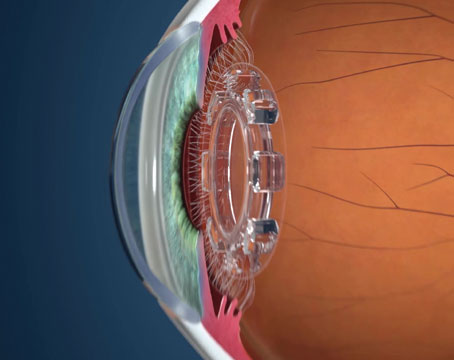Recently, a group in Australia has been conducting studies that suggest a new digital video technique they’ve developed for diabetic retinopathy screening has specificity and sensitivity equal to that achieved using the standard still-photo method, while being easier to do, providing a larger view of the retina and being less prone to technical failure. Furthermore, the simplicity of the process allows non-medical personnel to perform the test.
Because the resulting digital files are large, the group has al-so experimented with condensing the files to make them smaller and easier to send and store. That work has found that the files can be condensed to a small fraction of their original size and still produce accurate screening results, comparable to those achieved with traditional retinal photography.
A Different Retinal View
Daniel Ting, MBBS, a PhD student at the Center for Ophthalmology and Visual Sciences at the Lions Eye Institute, University of Western Australia, coauthor of several studies of the technique, notes that traditionally, retinal photography has been the most common method used by primary-care physicians for this type of screening. “Capturing a good quality retinal image is highly dependent on the operator’s ability to perform retinal photography, as well as patient compliance with instructions and tolerance of the bright light,” he says. “As a result, retinal photography is often performed by highly trained professionals, which makes it less accessible in a remote community. Moreover, even when performed by experienced retinal photographers, the reported technical failure rate of mydriatic retinal photography has been as high as 12 percent.
“Our method uses retinal video recording instead,” he continues. “This approach is quicker and easier to learn than traditional retinal photography, and it provides a greater field of view than three-field retinal photography—a view that simulates what is seen with a slit-lamp examination. And because this technique is easy to learn with minimal training, both medical and non-medical personnel can screen and monitor for diabetic retinopathy in the community, particularly in remote areas and developing countries.”
Dr. Ting’s group uses the EyeScan instrument from Ophthalmic Imaging Systems (Sacramento, Calif.) to record the videos. He says the idea for this approach to diabetic retinopathy screening came about because of the increasing need for screening that was evident in Australia. “Professor Yogesan Kanagasingam at Lions Eye Institute in Perth, Western Australia, developed the EyeScan instrument in 2009,” he explains. “He incorporated the retinal video recording function into the camera so that he could evaluate the effectiveness and user-friendliness of retinal video recording as a way to screen for diabetic retinopathy.”
Photos vs. Video
Dr. Ting’s group has published two studies of the new technique. The first compared their method of retinal video screening, using the EyeScan device, to the more traditional approach. Fundus images of 100 patients were captured by both photography and video; the results were interpreted by two ophthalmologists. The patients were also examined using slit-lamp biomicroscopy.
Compared with slit-lamp examination results, the sensitivity and specificity of video recording for detecting the presence of any diabetic retinopathy were 93.8 percent and 99.2 percent respectively for ophthalmologist #1, and 93.3 percent and 95.2 percent for ophthalmologist #2. By comparison, the sensitivity and specificity of traditional retinal photography were 91.8 percent and 98.4 percent respectively for ophthalmologist #1, and 92.1 percent and 96.8 percent for ophthalmologist #2. Both imaging methods had 100-percent sensitivity and specificity in detecting more severe, sight-threatening diabetic retinopathy.
|
Thirty-six retinal videos were compressed from 1 GB to 100 MB, 30 MB, 20 MB and 5 MB; the videos were interpreted by an ophthalmologist and a resident. Sensitivity and specificity were compared to the uncompressed videos. The sensitivity and specificity were greater than 90 percent for all compressed levels except 5 MB, where it dropped to 70.6 percent sensitivity and 94.7 specificity for the doctor and 80 percent and 72.2 percent for the resident.
“Because compressing the files doesn’t undercut their usefulness—and the video can be taken by non-medical personnel—this approach can be easily used for diabetic retinopathy screening in routine, mobile and tele-ophthalmology settings,” Dr. Ting points out. (He adds that compression of the files might not be necessary in routine screening.)
An Approach with Potential
Although the EyeScan device is currently used in clinics in many countries around the world, Dr. Ting says this kind of screening could be done with other video cameras if their function is similar to the EyeScan. “When we did our first study, EyeScan was one of the first retinal cameras to have this capability,” he explains. “That gave us the opportunity to be one of the first groups to describe this novel technique.
“The EyeScan was invented with the goal of increasing the diabetic retinopathy screening rate in the community by making it more affordable,” he adds.” For that reason, it’s currently mainly used in primary-care settings. But it clearly has the potential to be used by specialists as an in-office screening tool to diagnose and monitor patients with diabetic retinopathy.” REVIEW




